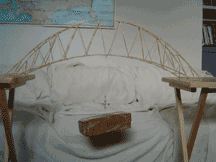|
To evaluate a truss like this one, you have to use trigonometry and physics. The sum
of the forces in the vertical and horizontal forces have to equal zero if a particular point
is not in motion.
In physics, you often simplify the problem to get a reasonable answer without an unreasonable
amount of work. To that end, I tip the truss upright and analyze only one truss. After practising
on a simpler version, I went ahead and made a variant of the Pratt truss here. All the diagonals
are at 60° and the other struts are vertical. To simplify the calculation of a curving
arch, I assume straight lines between the points which approximate the curve.
I am not going into a great deal of detail here because even I made a couple bridges without
doing this analysis, but if you get serious about it, it would be a good idea to 'do the math' as
it were. It may be beyond the scope of the assigment for many of you middle and high schoolers,
but if you submit an accurate stress analysis of your truss, you're sure to score some extra
points with the instructor.
I plan to build this bridge using round toothpicks and a method of affixing them that will
be suited for compression and tension joints. I used a ficticious 100 lb. weight at the center
of the bridge for my math problem and worked out each joint. The amount of weight at that center
point is a 'scalar' quantity. All the numbers can be thought of as percentages of the load. It
really is just to show which members are in tension ( pulling at the ends) and which members are
in compression ( pushing at the ends). So, for example, on join DE, the the load were only 10 pounds,the force in that link would be 2.09 instead of 20.9. That member is colored grey
and it is in compression. I have colored the members in tension a gold
color, and the ones in compression grey. If I had more than a couple of
these to do, I would devise a program to calculate the forces on each member.
|

 Lars' Creative Warehouse
Lars' Creative Warehouse

 Lars' Creative Warehouse
Lars' Creative Warehouse